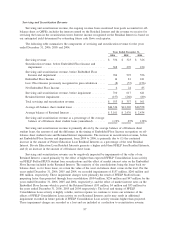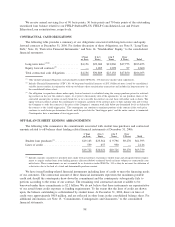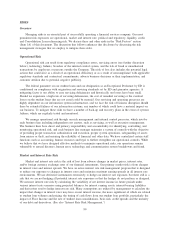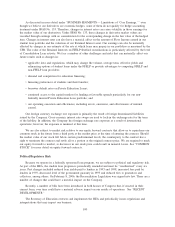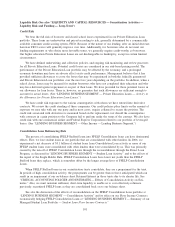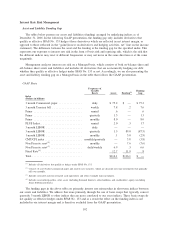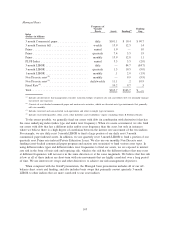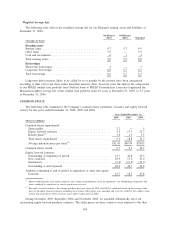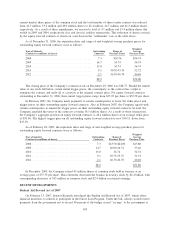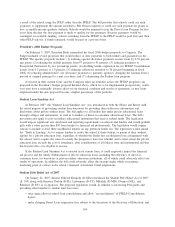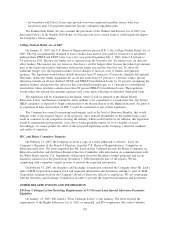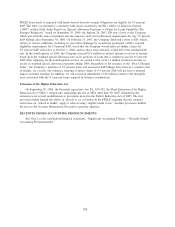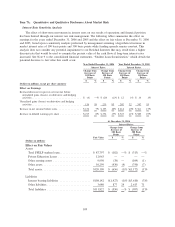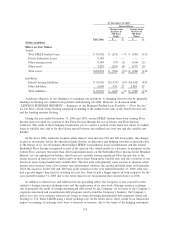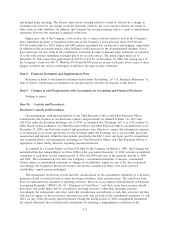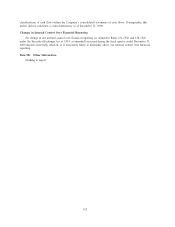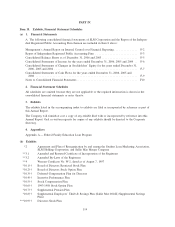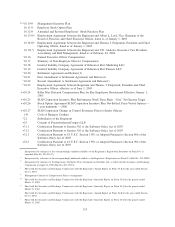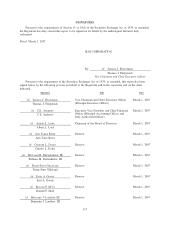Sallie Mae 2006 Annual Report Download - page 108
Download and view the complete annual report
Please find page 108 of the 2006 Sallie Mae annual report below. You can navigate through the pages in the report by either clicking on the pages listed below, or by using the keyword search tool below to find specific information within the annual report.• for borrowers with Direct Loans only, provide borrowers employed in public service with loan
forgiveness after 120 payments under the income contingent repayment plan.
The Student Debt Relief Act also contains the provisions of the Student Aid Reward Act of 2007 (see
discussion below). If the Student Debt Relief Act becomes law in its current form, it could negatively impact
the Company’s future earnings.
College Student Relief Act of 2007
On January 17, 2007, the U.S. House of Representatives passed H.R. 5, the College Student Relief Act of
2007. The bill was principally designed to lower student loan interest rates paid by borrowers of subsidized
undergraduate FFELP and FDLP loans over a five year period beginning July 1, 2007, from 6.8 percent to
3.4 percent in 2011. Because the lender rate is separate from the borrower rate, the interest rate cut does not
affect lenders. The interest rate cut, however, does have a sizable budget effect because the federal government
pays to the lender any positive difference between the lender rate and the borrower rate. To offset the
additional budget cost, the legislation makes several changes to increase costs to lenders and guaranty
agencies. The legislation would reduce default insurance from 97 percent to 95 percent, eliminate Exceptional
Performer, double the lender origination fee on all new loans from 0.5 percent to 1 percent, reduce special
allowance formula on all new Stafford, PLUS, and FFELP Consolidation Loans by 0.1 percent (exempting the
smallest lenders) and increase the offset fee that consolidation lenders pay, to 1.3 percent for consolidation
loan holders whose portfolio contains more than 90 percent FFELP Consolidation Loans. The legislation
would reduce the amount that guaranty agencies may retain upon collecting on defaulted claim-paid loans.
The legislation will be transmitted in the Senate, where it will be referred to the Senate Health,
Education, Labor, and Pensions Committee and is unlikely to be considered as a stand-alone bill. The Senate
HELP committee is expected to begin consideration of the Reconciliation of the Higher Education Act prior to
its expiration in June and sections of H.R. 5 could be considered as part of that legislation.
The Company has several loan pricing mechanisms, such as the level of Borrower Benefits, that would
mitigate some of the negative impact of this proposal. Also, reduced profitability in the student loans could
result in a number of our competitors leaving the industry which would benefit us. In addition, this legislation
would be implemented prospectively, so its effect would gradually impact us over a number of years.
Accordingly, we cannot predict the effect of this proposed legislation on the Company’s financial condition
and results of operation.
SEC and House Committee Requests
On February 13, 2007, the Company received a copy of a letter addressed to Albert L. Lord, the
Company’s Chairman of the Board of Directors, from the U.S. House of Representatives’ Committee on
Education and Labor. The letter requested that Mr. Lord and the Company provide the House Committee on
Education and Labor and the House Financial Services Committee with information on communications with
the White House and the U.S. Department of Education about the President’s budget proposals and recent
legislative initiatives for the period from November 1, 2006 through the date of the request. We are
cooperating with committee counsel in order to provide the requested information.
On February 15, 2007, the Securities and Exchange Commission contacted the Company about Mr. Lord’s
sales of SLM Corporation common stock and requested information and documents relating to sales of SLM
Corporation common stock by the Company’s Board of Directors, officers or employees. We are cooperating
with the Securities and Exchange Commission in order to provide the requested information and documents.
OTHER RELATED EVENTS AND INFORMATION
ED Dear Colleague Letter Restating Requirements of 9.5 Percent Loan Special Allowance Payments
Eligibility
On January, 23, 2007, ED issued a “Dear Colleague Letter” to the industry. The letter restated the
requirements of the Higher Education Act of 1965, as amended, and ED’s regulations that control whether
107


